 |
[ Outlaw Genealogy | Bruce
History | Lost Chords ] [ Projects | News | FAQ | Suggestions | Search | HotLinks | Resources | Ufo ] |
 |
[ Outlaw Genealogy | Bruce
History | Lost Chords ] [ Projects | News | FAQ | Suggestions | Search | HotLinks | Resources | Ufo ] |
Adam
Owtlawe, Mariner - 1533 - d. 1545 - mariner n. One who navigates or assists
in navigating a ship.
[ He was more than a "seaman" - one who knows
all aspects of sea science - ships - ship building - navigation ]
1533 - London
and Middlesex Fines: Henry VIII - London & Middlesex - Adam
Owtlawe, 'maryner,' - Easter Anno 25 1533
1535 - Sebastian
Newdigate (Nedygate) dies in the Tower for denying the King's
supremacy
1536 - Pilgrimage of Grace
1537 - Jane Seymour dies
after birth of Edward
VI
1537 - Pilgrimage
of Grace Suppression - 216 were put to death; lords and knights, half a
dozen abbots, 38 monks, and 16 parish priests
1538 - Hospitallers
Order of St Thomas was dissolved
, along with other monastic orders in England, by Henry VIII
1539 - Henry VIII had unsuccessfully required the English
knights in Malta to disavow the authority of the Pope.
1539 - SIR THOMAS SPERTT to
MR.
GONSON - Has received Gonson's and the lord Privy Seal's letters. Spertt, William
Hourrey, John Tebowrow, Adam Outlawe, and Richard Couchey have viewed the
Great Nicholas of Bristol, and find no fault except that she draws 3 fathoms of water in ballast and 3½ when laden. Find in her 6 port pieces, 2 slings, a small fowler, 8
bassys, 6 hacbus, 1 new cable, 2 worn cables, 3 hawsers, 3 anchors, 4 tope
armurs, 10 flags, 1 streamer. She is worth 700l. if it were not that she draws so much water.
Portsmouth, 5 Sept. - King Henry VIII papers
From its price and their description of the vessel it can be deduced that it must have been a very large ship. The Great Nicholas carried 21 guns. [ It is interesting that Adam Owtlawe was included in the inspection of this ship, noting that his opinion was of value to the treasurer of the Navy. (Thomas Spert was Head of Trinity House and Comptroller of the navy / William Gonson) ]
1540 - Suppression of the Hospitallers of St. John in England - The Hospitallers could not be described as belonging to a monastic order and so Templecombe escaped in 1536 the suppression of the smaller monastic houses and was not dissolved until 1540, when an Act of Parliament (fn. 3) placed the possessions of the Hospitallers in the hands of the Crown as of an Order more loyal to the pope than to the king and existing for the promotion of superstitious ceremonies.
1540 - King
Henry VIII visits Hull with his Queen.
( Catherine Howard married Henry VIII on 28 July 1540)
1541 - Adam
Owtlawe - (£30) - '1541 London Subsidy roll: Tower Ward - "Lord
Admiral" Sir John Dudley knight
- William Gunston Navy Comptroller
1541 - Margaret
Pole nee Plantagenet, Countess of Salisbury - is executed for Treason
1541 - William Gonson's son David
Gonson, Knight of Malta, is hanged, drawn and quartered at Southwark (London)
1541 - Sir Thomas
Spertt Dies in December
1542 - Catherine Howard and the three men were executed.
1543 - Henry VIII marries Catherine Parr;
makes an alliance between Henry and Charles V (Holy Roman Emperor) against Scotland and
France - Catherine married Henry VIII on 12 July 1543 at Hampton
Court Palace
1543 - Adam
Owtlawe - send four ships to the Downes - Feb 23 - Sir Francis
Brian
to the Kings Council - Scotch prisoners - Feb.19, 1543
| - - - - -
Adam Owtlawe's secret mission with Francis Bryan with
the young
knights Sir John
Clere and
Sir Henry Carey, first Lord Hunsdon ( the natural son of Henry VIII by Mary
Boleyn) and Thomas
Newdegate:
Full text of "Letters and Papers, Foreign and Domestic, Henry VIII" (by Sir Francis Brian)
Example of a Shallop
| - - - - - Report by Sir Francis Bryan :
1543 - Westminster., 19 Feb. Bryan ^ ' that the King is advertised of the troubles we were in upon the seas and the danger and ruin of his ships, and that I was determined according to your commandment to send four ships to the Downes. The said ships were ready in Humber before the receipt of your letters, whereupon I sent a boat which has spoken with Mr. Clere and Mr. Carye, commanding them to lie off and on upon the coast between Humber and Newcastle, and as Mr. Nedygate and Adam Owtlawe were ready victualled I thought it more convenient that they should accompany Mr. Clere and Mr. Carye, than lie in harbour.
As Clere and Carye went forth of Humber they met a Scot of 30 tons laden with salmon, herring and barrelled fish with the lord Admiral's safe-conduct for George Browne and Ant. Papeworth, of Barwike, to bring, in Scottish ships or boats, certain fish to Berwike, Holy Hand, Aylmouth or Stakton at price therein limited (given). As the Scot had passed the places appointed and said he was going to Boston, Sir John [Clere] and Mr. Carye sent him to Hull, and I have stayed him and certified my lord Admiral. Clere also took a French boat, as I reported, which is at Newcastle, and the men, 31 and 3 Dutchmen, brought in the ships to Hull, and I have, by advice of Mr. Stanhop, delivered all 34 to the mayor to keep them and see them gently handled. Begs to know how their charges shall be paid. Here awaits the coming of Mr. Osborn with the King's further pleasure. The French have delivered an inventory of their goods, valued at 500 mks., which is sent to the lord Admiral. Hull, 23 Feb. Signed. Pp. 2. Add. Endd. : a xxxiiij .
[ Notice that Sir Francis addresses his "peers" as Mr. - Mister - (Master) and others like Adam Owtlawe, by their first and last names. ]
| - - - - - -
King Henry VIII's last Hurrah like so many of the characters involved.....
The expedition of 1544:
1544 - The Salamander and the Scottish-built Unicorn were captured at Leith and used as transport for the return journey as part of Lord Hertford's army 14 May 1544 - The Rough Wooing
I would think that Adam Owtlawe would have been part of the Scottish Invasion in May/April 1544 but I'm still looking ...
Burning of Edinburgh (1544) - Orders for the fleet at Tynemouth were given on 28 April. All the ships were to be ready to weigh anchor at a favourable wind. The Lord Admiral, Viscount Lisle's flagship would fly the St George Cross on the fore-top mast and two top-lights at night. The ships of the 'vaward', the vanguard, would follow and anchor as near as possible. Hertford and the treasure-ship (Ralph Sadler was treasurer) would follow with his ensign on the main-top mast of the Rose Lion with two night lights on the shrouds. The Earl of Shrewsbury, captain of the rear-ward would fly the ensign on his mizzen mast, with a cresset light in the poop deck at night. The other ships were not to show flags or lights. Any ship that was transporting base or double base guns was to mount them on the fore-deck for the landing
1544 - Henry VIII and Charles V invades France
Timeline of the Batte of Boulogne - The Tudors Wiki
Sieges of Boulogne (1544–1546) - the Duke of Suffolk, moved to the coast town of Boulogne and laid siege to it on 19 July
1544 - July 1544 Expedition to Calais - Captain Adam Owtlawe
1544 - Henry FitzAllen - April 1544 he was made knight of the Garter. In July 1544 he commanded with Suffolk the English expedition to France as Lord Marshal, and besieged and took Boulogne - Henry lorde marquis of Dorset
Letters and papers, foreign and domestic Henry VIII..
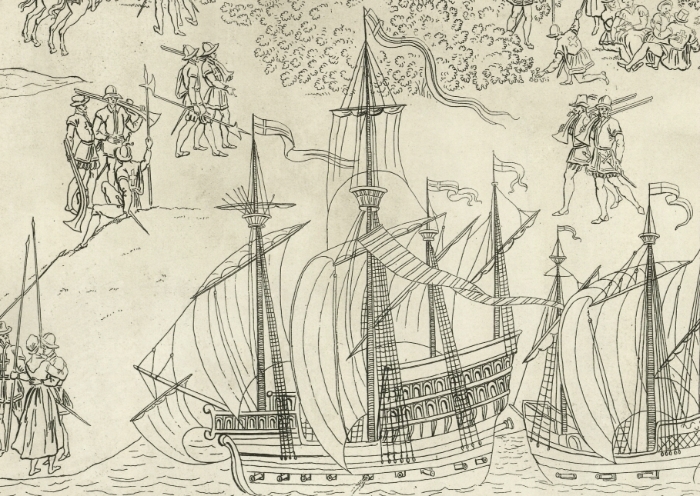
A four masted ship announces her arrival off Calais in July 1544 by firing the fifth gun on her main
gundeck. .... It is
quite possible that this is the Mary Rose shown before she sank in the Battle of the Solent in July 1545.
Appendix Letters and Papers, Foreign and Domestic, Henry VIII, Volume 19 Part 2 (pp. 479-487)
Diary of the Invasion of France.
The English historical review - contains an Account of the Expedition of 1544
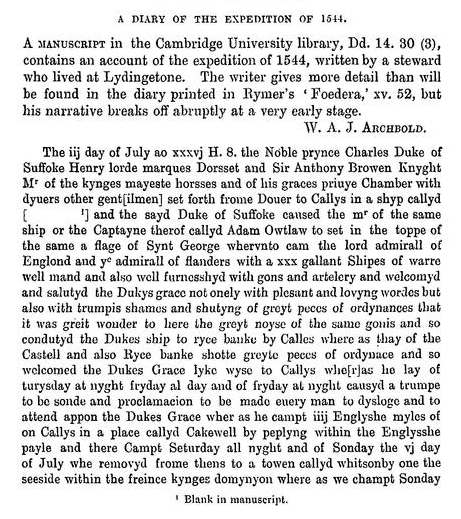 A manuscript in the Cambridge University Library, Dd. 14. 30 (3), contains an account of
the expedition of 1544, written by a steward who lived iat Lydingstone. The writer gives more detail than will be found in the diary printed in
Rymer's `Feodera,' xv. 52, but
his narrative breaks off abruptly at a very early stage.
A manuscript in the Cambridge University Library, Dd. 14. 30 (3), contains an account of
the expedition of 1544, written by a steward who lived iat Lydingstone. The writer gives more detail than will be found in the diary printed in
Rymer's `Feodera,' xv. 52, but
his narrative breaks off abruptly at a very early stage.
W.A.J Archibold.
July 3, 1544 :
![]() The
3rd day of July 1544 the Noble Prince Charles,
Duke of Suffolk,
Henry lorde
marquis of Dorset and Sir Anthony Browen Knight
[Mr] Master of the
Kings majesty horses, and of his graces Privy Chamber with diverse other
gentlemen set forth from Douer [Dover]
to Callys in a ship called [ blank ] and the said Duke of Suffolk caused the Master of the same ship or the
Captain
thereof called Adam Owtlaw to set in the top of the same, a flag of
Saint George where unto came the Lord Admiral of England
and the Admiral of Flanders with 30 gallant Ships of war, well manned and also well furnished with guns and artillery
and welcomed and saluted the Dukes grace not only with pleasant and loving words
but also with trumpets shames and shooting of great pieces of ordinances that it was
great wonder to hear the great noise of the same gun's and so conducted the Dukes ship to
[the Ryce Banke by Calles, whereas they of The Castle and also
The Ryce Banke saluted and shot great pieces of ordinance and so
welcomed the Dukes Grace likewise
to Callys, whereas he lay off Thursday at night and Friday all day, and of
Friday at night caused a trumpet to be sounded and proclamation to be made every
man to dislodge and to attend upon the Dukes Grace where as he camped iij English
miles off on Callys in a place called Cakewell by Peplyng within the English
Pale and there camped Saturday all night and of Sunday the 6th day of
July, we removed from
thence to a town called Whitsonby on the seaside within the french king's dominion,
where we camped till Friday.
The
3rd day of July 1544 the Noble Prince Charles,
Duke of Suffolk,
Henry lorde
marquis of Dorset and Sir Anthony Browen Knight
[Mr] Master of the
Kings majesty horses, and of his graces Privy Chamber with diverse other
gentlemen set forth from Douer [Dover]
to Callys in a ship called [ blank ] and the said Duke of Suffolk caused the Master of the same ship or the
Captain
thereof called Adam Owtlaw to set in the top of the same, a flag of
Saint George where unto came the Lord Admiral of England
and the Admiral of Flanders with 30 gallant Ships of war, well manned and also well furnished with guns and artillery
and welcomed and saluted the Dukes grace not only with pleasant and loving words
but also with trumpets shames and shooting of great pieces of ordinances that it was
great wonder to hear the great noise of the same gun's and so conducted the Dukes ship to
[the Ryce Banke by Calles, whereas they of The Castle and also
The Ryce Banke saluted and shot great pieces of ordinance and so
welcomed the Dukes Grace likewise
to Callys, whereas he lay off Thursday at night and Friday all day, and of
Friday at night caused a trumpet to be sounded and proclamation to be made every
man to dislodge and to attend upon the Dukes Grace where as he camped iij English
miles off on Callys in a place called Cakewell by Peplyng within the English
Pale and there camped Saturday all night and of Sunday the 6th day of
July, we removed from
thence to a town called Whitsonby on the seaside within the french king's dominion,
where we camped till Friday.
[ blank in manuscript ] ( English Pale - Invaded Land controlled by English
forces)
( It's really irritating that the name of Adam Outlawe's "The Duke's Flag Ship" is blank! .. but it is interesting the guy writing the diary knew exactly who Adam Outlawe was! )
We may be able to determine the name of the ship since it was the ship that carried the Duke of Suffolk, Sir Anthony Brown and the other lords and wanted to signal to Lord Admiral (probably John Dudley ) and the Admiral of Flanders which ship they were on i.e. the "flag ship". So the possible flag ship would have been most likely The Mary Rose, Peter Pomegranate or the Henry Grace à Dieu
This ship may have been The Mary Rose - The Mary Rose and the Cowdray Engravings
The Sister ship was Peter Pomegranate - It had a tonnage of 450 when first built, but in 1536 it was rebuilt and enlarged to a tonnage of 600; at that date the name was shortened to Peter (Catharine had fallen out of grace; she died in 1536).
The other great shipp was Henry Grace à Dieu - ("Henry Grace of God"), also known as Great Harry, was an English carrack or "great ship" of the 16th century. ... Very early on it became apparent that she was top heavy. She was plagued with heavy rolling in rough seas and her poor stability impacted gun accuracy and general performance as a fighting platform. To correct this, she underwent a substantial remodeling in 1536 (the same year as Mary Rose) where height of the hull was reduced. In this new form she was 1000 tons burthen and carried 151 guns of varying size, including 21 of bronze, and her full crew was reduced to between 700 and 800. Furthermore, she got an improved and innovative sailing arrangement with four masts each divided into three sections; the forward two square rigged with mainsail, topsail and topgallants and the aft two carrying five lateen sails between them. This allowed for easier handling of the sails and spread wind forces more evenly on the ship, resulting in better speed and maneuverability and allowed better use of the heavy broadside. The only surviving depiction of the craft (from the Anthony Roll) shows this rebuilt version[2].
Henry Grace à Dieu saw little action. She was present at the Battle of the Solent against French forces in 1545, in which the Mary Rose sank, but appears to have been more of a diplomatic vessel,
The Cowdray engravings are a set of images recording Henry VIII’s campaign in France during the summer of 1544 and the events of 19th July 1545 in
Portsmouth, the Solent and the Isle of Wight, showing the attempt by the forces of the French King, Francis 1st, to invade England and wrest the crown from Henry. One of the most notable events that occurred during the
“Battle of the Solent” was the loss of King Henry VIII’s vice flagship, the Mary Rose, and her sinking is clearly shown in this picture.
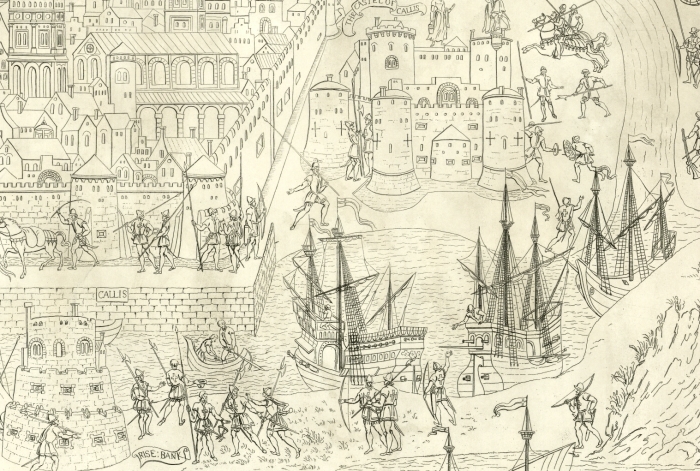
Detail from the departure of King Henry VIII from Calais in July 1544 with English ships in the harbour and Calais Castle
above.
The image shows the departure of King Henry VIII from Calais in July 1544. There are identifiable features in the landscape and high on the hill to the south of Calais, in the top right-hand section of the image, is
Sir Anthony Browne greeting King Henry VIII with these events being witnessed by many of their troops. Importantly, in the foreground of this image as there is also a four masted ship, which is equipped with nine guns on its main gundeck, each fitted with lidded gunports.
The fifth gun on the port side is being fired, probably in announcement of the ship’s arrival at Calais. It is not unreasonable to suppose that because the loss of the Mary Rose was an important event shown in the Portsmouth painting,
Sir Anthony Browne would have required an image within the set of paintings which depicted the Mary Rose as she had been before she sank.
This is therefore most probably the last Tudor image made of the Mary Rose afloat.
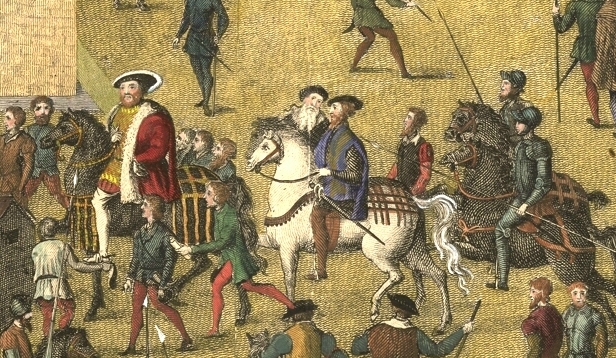
King Henry VIII followed by Sir Anthony Browne and Sir Charles Brandon 1st Duke of Suffolk
Mary Rose
- ... Very little is known of the
identity of the men who served on the Mary Rose, even when it comes to the names
of the officers, who would have belonged to the gentry. Two admirals and
four captains (including Edward and Thomas Howard, who served both positions)
are known through records, as well as a few ship masters, pursers,
master gunners and other specialists. Of the vast majority of the crewmen,
soldiers, sailors and gunners alike, nothing has been recorded....
The Mary Rose would have carried a captain, a master responsible for
navigation, and deck crew.
The fact that Adam Outlawe was the master of this ship must have been a highlight of his career in the Navy.
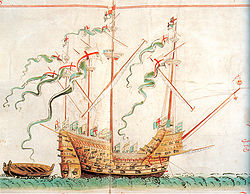 In 1545 Lord
Admiral John Dudley, Viscount Lisle welcomed King
Henry VIII on board the Henri
Grace a Dieu, popularly called Great Harry
In 1545 Lord
Admiral John Dudley, Viscount Lisle welcomed King
Henry VIII on board the Henri
Grace a Dieu, popularly called Great Harry
Ryce banke is Resbank and "Tower of Ruisbank" in Calais and The Castle is the Castle at Calais
Cakewell - Coquelles : Peplyng - Peuplingues : Calles - Calais : Whitsandebaye - Wissant (Whitsand) Bay : Boulogne-sur-Mer
Charles Brandon, "Prince Charles", 1st Duke of Suffolk - Henry FitzAlan, 19th Earl of Arundel - Anthony Browne (died 1548) - Sir John Gage (Tudor politician) - In 1544 he undertook an important role for the invasion of France, organising transport and supplies for the army, and he became a knight banneret.
Admiral of the fleet in 1544 was Thomas Seymour Lord Admiral of England Jan 1544 was Lord Lisle John Dudley Admiral of Flanders 1544 - Maximilian II of Burgandy
"Ryce banke" is Resbank and "Tower of Ruisbank" in Calais and "The Castle" is the Castle at Calais
List
of Captains, Lieutenants and Lords Deputies of English Calais
...
Calais had also castellans
(of Calais
Castle); "Captain of Calais Castle" is a different post
from "Captain of Calais", the title of the top commander and
military governor of the Pale for most of the period.
Calais - The old part of the town, Calais proper (known as Calais-Nord), is situated on an artificial island surrounded by canals and harbours
| - - - - -
The Royal Beer Run of July 1544
Henry VIII - July 1544, 6-10 - The Royal Beer Run
5 July.847. Suffolk and Browne to Henry VIII.
R. O. Winchester reports that he has letters from Mr. Halle declaring that the wagons, lymoners and mares out of Flanders will be at Calais tomorrow, as by Halle's letters to the Privy Council will appear.
Have with their whole number departed from Calais this Saturday because of the scarcity of horsemeat (of which they wrote yesterday) and to leave the town clear against Henry's coming, which they think should now be "the rather the better," and they trust he will here find nothing lacking.
Are tonight encamped at Cawkewell and will tomorrow night lodge in the enemy's ground between Marguison and the sea, 10 miles from Calais, as they wrote yesterday.
Camp at Cawkewell, 5 July. Signed.
7 July.868. Suffolk, Gage and Browne to Henry VIII. - R. O. Have presently received letters from my lord of Norfolk, my lord Privy Seal and Mr. Treasurer, and (being very sorry to see them in that need) have concluded to send 400 or 500 tun of beer, to be conveyed by Flemings, under conduct of the writers' soldiers, to St. Omer's, and thence to their camp under conduct of theirs. For this, Gage departs tomorrow early, to Calais. Will also send them such money as can here be spared, and will rather strain folks here than see them lack, "considering their journey importeth a great matter, and their return without anything doing should not sound all to your Majesty's honor." Enclose their letters. At the camp beside Whitsandebaye, 7 July. Signed.
10 July.882. Suffolk, Gage and Browne to Henry VIII. - Yesterday, received [letters] from the Privy Council [showing] that Henry intends to set forth hitherwards on Friday next. (fn. 14) Expect he will reach Calais in seven or eight days. All victuals are in good order, and of carriage there shall be no lack. The ordnance is arrived and nearly unshipped, but the great pieces will require time to mount. All men are come except those out of Suffolk, Essex and those parts, and such as are appointed to attend the King from Dover. Departed from Calais so soon in order to spare the English Pale against his coming, seeing that there is no hay left, old or new, and, if the grass were spoiled, great lack would ensue at the coming home. Departed when their number was still very small and they had only 14 small pieces and one barrel of powder; but now their number is increased and they have, as instructed, laid 1,000 men at Guisnes, and 600 to defend the East Pale, and now they must send horsemen to St. Omer's to conduct the money appointed to be sent to Norfolk and the lord Privy Seal. By the Council's said letter they are directed to march to Boleigne and begin the siege, leaving the King's own band to tarry for him at Calais.
10 July.883. Suffolk, Gage and Browne to the Council - Enclose letters presently received from Norfolk and the rest of the Council, touching the state of their camp, for whose relief the writers have taken order. From the camp at Whitsandebaye, 10 July. Signed
10 July.885. Suffolk, Gage and Browne to [Norfolk] - Have considered his Lordship's letters and despatched them to the Council. Understand by his trumpet that he marvels that he has received no letters from them since their arrival on this side the sea. If it had been so they could not much blame him; but they have written to him once or twice every day. As to his relief with victuals they despatched 80 tun of beer, and trust that it is received. Have written divers times to know what he wants, so that they may make a staple at Sainct Omer's for him. Albeit he never wrote that he lacked bread, or anything but drink, so that no great store of wheat was sent, they sent 500 qr. of malt, with brewers. After speaking with Jeronimus on Sunday last,* despatched him within one hour to his Lordship, thinking that at the approach to Monsterell he should be there to effect what he had devised. Marvel that he is not yet arrived. "We also understand by your trumpet that the Great Master keepeth no promise with you, which seemeth to us to mean somewhat more than we can now divine. For the situation of Monstrell, the strength of the same and the power that is in it we understand, as well by your letters as by your said trumpet, that the same is nothing so easy to be besieged nor to be had as the King's Majesty hath been informed, and can for our parts say nothing to it, but beseech God to send you as good speed as we would wish ourselves. From the camp besides Whitsandebaye," 10 July. Signed.
1544 - Sept
11 - We assailed the castle yesterday in play, but the defence was so earnest that "a great number of our men are hurt and some slain,
1544 - Sept 14
- The English Capture of Boulonge - The town was restored to the
French on the conclusion of peace (1550). - The town and castle of Boulogne to be delivered to the King tomorrow, 14 Sept., at 10 a.m., with all artillery, powder and
munitions
1544 - William Gonson's wife dies
1544 - Ships
- Great Shallop of Dover (Adam Owtlawe, c) - Cavendishe Shallopp
(Adam Owtlawe, c.) November 28 1544
From: 'Henry VIII: November 1544, 26-30', Letters and Papers, Foreign and Domestic, Henry
VIII, Volume 19 Part 2: August-December 1544
xv. Payments (like those in § ii.) made 14 Sept. for the Dragon (Dunstone Newdigat, captain), Great Pynneas (Robt. Garthe, c), Newe Barke (Thos Windane, c), Lytell Shallopp of Dover (Thos. Huttone, master), Great Shallop of Dover (Adam Owtlawe, c), New Pynnas made by Jamys Baker (John Borlye, c), Swalloo (Wm. Tyrell, c.), Great Gallyon (Sir Wm. Wodhowse, c), Mynyon (Wm. Cornocke, mr.), Lyon (Wm. Broke, c), Mary Jamys (John Bucke, c). Signed by recipients, three of them with marks.
xxiv. Payments (mostly like those in § ii.) made 20 Oct. for the Newe Barke (Thos. Windhame, captain), Lytell Shalloppe (Thos. Huttone, master), Newe Shallopp (John Booerley, c.), Cavendishe Shallopp (Adam Owtlawe, c.), Marye Jamys (John Cranewen, mr.), Greater Pynneas (Robt. Garthe, c.), Post of Deepe (Cornells Durport, mr.) and Facone Lysleye (Thos. Harding, c.). Not signed. (1905), pp. 396-421.
Letters and Papers, .Foreign and Domestic, of the Reign of Henry VIII: pt.1. -
He [Mr. Seymour] and Mister Carey doubt how ... the New Bark will stand the Narrow Seas this winter - Dover - 6 November 1544
Mr. Carey has been sick in bed three days and cannot yet rise to come a-land. Will send with the victuals... the New Barke,... and the Lesse Shalope. The rest remain here until he knows whether the King will have him meet with the fleets coming from Bordyowes, for which purpose he would choose...
"Ships appointed by Mr. Seymour to conduct the victuals from Portesmouth to Bulloyn." ... New Barke
Letters and Papers, Foreign ... - As yet, I hear no word what is become of the Grete Shalop.... by reason of the 'holoues' of the seas, that they were strained continually to pump, and specially ... the New Barke...
The Seymour family, history and romance
...
The news that a French fleet had put to sea, in the autumn of 1544, in order to cut off communication between
Boulogne and England, brought a new honour for Sir Thomas Seymour. He was appointed Admiral of the
King's Navy with instructions to convey a great quantity of provisions to Boulogne.
This accomplished, he was ordered to station the warships in mid-channel, and at the
same time, if possible, to ' appoint a convenient numbre of the small shallopps and other small vessels to passe in the
River Estaples, and there burne and bring away suche vessells of thenmies as may be there found, or do such
other annoyaunce to thenmies as the tyme will serve.'
On the 6th of November 1544 Seymour wrote to the Council advising that he should attack the coasts of Brittany
...A violent storm spoilt an intended attack on some of the enemy's ships which were
lying at Dieppe and in the Seine, and, being obliged to take recourse to the open sea,
his ships were so battered that the next day he reached the Isle of Wight with only part of the fleet,
all the boats having been lost during the night.
The king, being quick to anger, evidently conveyed his dissatisfaction at the failure of the enterprise to the
admiral through the Privy Council. Thus, on the 13th of November, Seymour wrote to the Council that he had
received their letters and 'perseve be the same that I am thought neglegent in the accomplechement of the Kynges
Heynes plesur.
This action appears to be the cause of Adam Owtlawe's death in 1544....
1544 - Owtlawe, Adam, [no place] 21 pynnyng - Prerogative Court of Canterbury - Probate Wills page 397 - Is this the same man? Did he die at sea? He was alive in October, this reference has just the year , no month (FYI - This is the court that would be used for someone who had died at sea).
1545 - Will of Adam Owtlawe - 09 January 1545 - Records of the Prerogative Court of Canterbury - Pynnyng - The PCC was the most important of these courts dealing with relatively wealthy individuals living mainly in the south of England and most of Wales. If a property-owner in England or Wales died overseas, such as sailors or soldiers, then their will was proved in the Prerogative Court of Canterbury regardless of where their property was held. - Adam Owtlawe Will - Had a wife named Alice and a son named Thomas and/or a son named Adam (it is very hard to read, so if know old wills, have a look and let me know.)
1545 - Dec
22 - For a weye of salt delivered to Brymer Outlawe, 30s.
14l. 16s. 8d. - Henry VIII: Papers - Somehow Related? Relative of
Adam? BRYMER is of Belgium origin, a locational name meaning
'one who lived by the sea-shore'. Not a common first name.
The "weye of Salt" may have
been a bereavement gift from Henry VIII no less.
example: Reynold
Calle's will 1501... To Robert Calle, nephew, a ' weye of salte '...To the Nunns
of Bunngaye, one weye of salt...To Ehzabeth Well, niece, 10s., a gowne and the
hood, one weye of salt, a little goblet of silver and 3 silver spoons.... I
still haven't found yet an explanation of the custom.
1545
- Mr. Stanhop was knighted
1546 -
Benjamin Gonson (William Gonson's son) becomes "Surveyor of all
our Shippes" (age 40)
1547 - Henry VIII
dies, Elizabeth was 13 years old, and was succeeded by her half brother, Edward
VI. Edward
Seymour acts as
Protector
1547 - Catherine Parr
married her final husband, Thomas
Seymour
1548 - Catherine Parr dies September 1548
birthing Mary Seymour
1548 - Thomas
Outlawe - King
Edward VI. issued a proclamation, Oct.
1548 - accused of piracy - 300 crown reward -
(Possibly Adam Owtlawe's son - and pirating for Thomas Seymour)
1549 - Lord Thomas Seymour of Sudeley was beheaded for treason on 20 March 1549
1550 - Sir Francis Bryan dies in Ireland (possibly poisoned)
1552 - Sir Stanhop(e) was beheaded.
1552 - Edward
Seymour was executed for conspiracy in 1552
1553 - King
Edward VI died on 6 July 1553, aged 15
1553-1558 - Queen
Mary I Reigns - renewal of Catholic Power - she had almost 300
religious dissenters burned
at the stake in the Marian
Persecutions, earning her the sobriquet
of "Bloody Mary". Thousands imprisoned
1558–1603 - Queen
Elizabeth I begins her Reign - 17 November 1558 – 24 March 1603
1559 - Ther
was a great complaynt made by one Adam Owtelaw to the clarke of the
markett that the brewers and bakers use to measure and streke the corne that
thei bye w' a rolle w ch hathe not be sene in eny other place. - Court on
Wednesday, 21 June [1559] - CITY OF NORWICH. ( This might be
Adam Owtlawe's son )
1561 - James
Bressey - Will
was proved on 25 October 1561. Buried in St. Magnus Churchyard in London
Witnesses: Hamnet Bressey, Robert Byrne, Andrew Outlaw, the writer hereof
- Bressey - was "servant to the Earl of Hertford", Edward Seymour (born
1537).
Edward Seymour was a brother of Jane Seymour, third wife of Henry VIII,
and of Thomas Seymour, who married Catherine Paar, Henry's sixth and last wife,
after the king's death. - Somehow related?
| - - - - - - - - - - -
Now for background on the interesting characters of this story..... This shows the company Adam Owtlawe kept :
| - - - -
It is interesting in inspection of the ship Great Nicholas of Bristol John Tebowrow "Teborow" appears to be John Husee and Lord Lisle's man . John Husee, was a solicitor and servant of the Lisles' . It is interesting who Lord Lisle was then : (Vice Admiral of the Navy and Illegitimate son of Edward IV).
So John Tebowrow served as witness to the inspection of the ship for Lord Lisle
Interestingly Adam Outlawe lived in the Tower Ward along with Lord Admiral John Dudley , Lord Lisle Plantagenet's stepson by his first wife and William Gonson the Paymaster of the Navy , much Later the Trinity Navy House would move to Tower Street Ward (1793-6)
Book 2, Ch. 27 - Tower Ward A New History of London (pp. 668-671)
Trinity House.
About the middle of Water-lane, on the west side, stands the Trinity house,
belonging to the fraternity of the Holy Trinity in the parish of Deptford Strond.
This society was founded in the year 1515, by Sir Thomas Spert, knt.
comptroller of the navy to Henry VIII. for the regulation of seamen and the
convenience of ships and mariners on our coasts. ...
I've checked and the records of the Trinity Mariners Guild were destroyed in the great London fire of 1666 so that might have told us where Adam Outlawe was in the Mariner hierarchy , But it is clear that he was very high up if he was inspecting a ship with Thomas Spert the comptroller and lived in the same ward as William Gonson he must have been important.
| - - - -
(Sir Francis Bryan was a distinguished diplomat, soldier, sailor, cipherer, man of letters, and poet.) (Henry VIII)
 England Under The Tudors
Sir Francis Bryan (d. 1550) (early-fifties in 1543)
England Under The Tudors
Sir Francis Bryan (d. 1550) (early-fifties in 1543)
SIR FRANCIS BRYAN* (b. 1490 - d. 1550), poet, translator, soldier, and diplomatist, was the son of Sir Thomas Bryan, and grandson of Sir Thomas Bryan, chief justice of the common pleas from 1471 till his death in 1500. His father was knighted by Henry VII in 1497, was 'knight of the body' at the opening of Henry VIII's reign, and repeatedly served on the commission of the peace for Buckinghamshire, where the family property was settled. Francis Bryan's mother was Margaret, daughter of Humphry Bourchier, and sister of John Bourchier, lord Berners. Lady Bryan was for a time governess to the princesses Mary and Elizabeth, and died in 1551-2. Anne Boleyn is stated to have been his cousin; but we have been unable to discover the exact genealogical connection.1
In 1526 he lost an eye in a tournament at Greenwich, and had to wear an eye-patch from then on. Bryan was a second cousin of both Anne Boleyn and Jane Seymour. No portrait of Sir Francis survives. Catherine Howard married Sir Francis's mother's brother, so was a cousin also.
Sir Francis returned to favour following Cromwell's demise, becoming vice-admiral of the fleet.
In 1543, on the appointment of John Dudley, Lord Lisle as admiral, Bryan was made vice-admiral because of ‘his experience in sea matters’.
As a member of the privy council Bryan took part in public affairs until the close of Henry VIII's reign, and at the beginning of Edward VI's reign he was given a large share of the lands which the dissolution of the monasteries had handed over to the crown. He fought, as a captain of light horse, under the Duke of Somerset at Musselburgh 27 Sept. 1547, when he was created a knight banneret.
Mr
Clere is likey Sir John Clere (b. 1511 - d. 1557) - The Cleres inherited Blickling
Hall and estate in the late 1500s. The previous owners were the Boleyn
family, relatives of Anne Boleyn the second wife of Henry VIII. Edward
Clere had been knighted by Elizabeth I in 1580 and the family was extremely
wealthy. Edward, however, squandered away the fortune and died a bankrupt in
1611. His widow was forced to sell the house.
Sir
John Clere - 1544 - (other
Clere's - Sir Thomas (d. 1544) Sir Edward ) (in his mid-thirties in
1543)
Mr. Carye is
likey Henry Carey, first Lord Hunsdon (1524?-1596), governor
of Berwick and chamberlain of Queen
Elizabeth's household, born about 1524, was 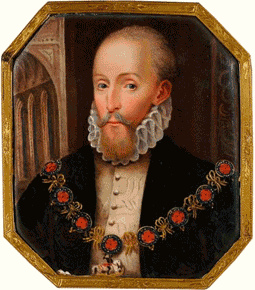
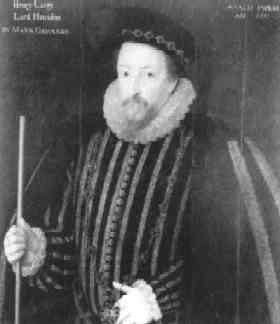 only son of William Carey,
esquire of the body to Henry
VIII, by his wife Mary, sister of Anne
Boleyn and daughter of Sir
Thomas Boleyn. Through his mother he was first cousin to Queen
Elizabeth. His father died of the
sweating sickness in 1528, and his mother remarried Sir William Stafford,
who died 19 July 1543. (in his early-twenties in 1543)
only son of William Carey,
esquire of the body to Henry
VIII, by his wife Mary, sister of Anne
Boleyn and daughter of Sir
Thomas Boleyn. Through his mother he was first cousin to Queen
Elizabeth. His father died of the
sweating sickness in 1528, and his mother remarried Sir William Stafford,
who died 19 July 1543. (in his early-twenties in 1543)
Carey first comes into notice as member of parliament for Buckingham at the end
of 1547; he was re-elected for the same constituency to the parliaments of April
and November 1554, and of October 1555. In 1549 Edward
VI granted him the manors of Little Brickhill and Burton in Buckinghamshire.
He was knighted by his relative Queen
Elizabeth soon after her accession, and was created Baron Hunsdon on 13 Jan.
1558-1559, receiving on 20 March following a grant of the honour of Hunsdon and
manor of Eastwick in Hertfordshire, together with other lands in Kent.
Henry CAREY (1° B. Hundson) - Said to be son of Henry VIII by Mary Boleyn, officially son of Sir William Carey. The King granted the Carey's actual manors and estates during the affair and immediately before the child's birth.
Sir Thomas Spert - was the first Master of Trinity House in 1514. Born in the late 15th century (date unknown), he died December 1541. He was in turn master of the Mary Rose (before it sank) and the Henri Grâce à Dieu, both ships being flagship to Henry VIII of England. A commoner, he was knighted by Henry at the Palace of Whitehall in 1524. Spert Island off the coast of Antarctica is named for him.
Mr. Nedygate is Thomas Newdegate - a relative of John Newdegate Esq. of Harefield, (or more likely his son John Newdegate Esq.) born 6 Henry VII; dying in 1545 was succeeded by his eldest son. John Newdegate Esq. of Harefield MP for Middlesex in 1571, 1573, 1574
It is interesting that John Newdegate brothers, Sylvester and Duncan, were Knights of St John, and another brother Sebastian who was tortured by Henry VIII for the supremacy thing... He also had a sister/aunt? named Jane who knew Sir Francis Bryan
It is interesting that later in 1561 - Thomas Newdegate was trustee to a will with William Gardiner, someone connected to the MayFlower
Mr. Stanhop is Sir Michael Stanhope - Sir Michael Stanhope (ca. 1518 – 22 January 1552) was a Nottinghamshire landowner and suspected rebel against the English Crown. He was a descendant of the ancient Stanhope family of Rampton, Nottinghamshire. He was knighted in 1545. He was implicated in the events which led to the downfall of his brother in law Edward Seymour, 1st Duke of Somerset, Lord Protector of England, was arrested in 1551, convicted of treason and beheaded in 1552 alongside Sir Thomas Arundell - (he was 25 in 1543)
Mr. Osborn is John Osborne, comptroller of the King's ships - September 1542 - John Osborne, comptroller, of the King's ships and works at Detford and other places within the realm
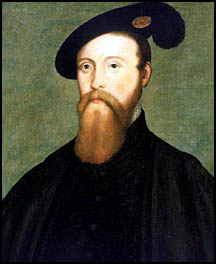 Mr. Seymour is Sir
Thomas Seymour - born c. 1508 - executed March 20, 1549
by order of Edward VI's privy council (age 36 in 1544)
Mr. Seymour is Sir
Thomas Seymour - born c. 1508 - executed March 20, 1549
by order of Edward VI's privy council (age 36 in 1544)
4th son of Sir John Seymour
and brother of Jane Seymour & Edward Seymour. His connections ensured his promotion, and he quickly won the favour of the King, who gave him many grants of land and employed him in the royal household and on diplomatic missions abroad. From 1540 to 1542 he was at Vienna, and in 1543 in the Netherlands, where he served with distinction in the war against France, holding for a short time the supreme command of the English army.
In 1544 he was rewarded with the post of master of the ordnance for life, becoming admiral of the fleet a few months later, in which capacity he was charged with guarding the Channel against French invasion.
Thomas Seymour, 1st Baron Seymour of Sudeley - ... Thomas also bribed a man called John Fowler, one of King Edward VI's closest servants, from whom he received information that the King frequently complained about the lack of pocket money he received. Thomas smuggled money to the King and began to voice open disapproval of his brother's administrative skills. As Lord High Admiral, he was able to control the English navy, and he openly asked people for support in case of a coup. As admiral, he also encouraged piracy, after bidding to capture the pirate Thomas Walton (Pirate), Thomas Walton instead made an agreement for a share of all booty seized by him. He was completely and thoroughly indiscreet in his bid for power.
Then there's Mary Seymour who for a time was held at Wexford Ireland:
Mary Seymour - ... Mary was also believed to have been removed to Wexford, Ireland and raised under the care of a Protestant family there, the Harts, who had been engaged in piracy off the Irish coast under the protection of a profit sharing arrangement with Thomas Seymour. A lozenge-shaped ring inscribed "What I have I hold" reputed to have been an early gift to Thomas by his brother Edward passed down through her descendants the Seymour-Harts up to at least 1927.
Edward Seymour was the senior political figure in the reign of Edward VI before he was levered out of power by John Dudley, Duke of Northumberland. Edward Seymour, regardless of his loyalty to the king, was executed for conspiracy in 1552.
Joan Fitzgerald, Countess of Ormond - Lady Joan was born in Desmond Castle, Kinsale, County Cork, Ireland in about 1509[4] or 1514,[5] the daughter and heiress-general of James Fitzgerald, 10th Earl of Desmond and Amy O'Brien. ... she was persuaded to marry the English courtier and diplomat Sir Francis Bryan in August 1548. He was appointed Lord Chief Justice of Ireland and the couple returned to Ireland in November 1548, where she had a son Sir Francis and a daughter, Elizabeth
Francis Bryan was born June 1, 1490 in Munster, County Clare,
Ireland and died Feb 2, 1550 in Clonmel,
Tipperary, Ireland.[ possibly piosoned] He was Chief
Gentleman for the Privy Chamber for Henry VIII of England.
Sir Francis Bryan married Joan Bryan, Duchess of Ormond (born Fitzgerald), they
had two sons, Francis "Justice of Ireland" II and Edward Bryan, Lord
of Upper Ossary. Francis Bryan I parents were Thomas "Thomas de
Bryan" III and Margaret Bryan (born Bourchier).
| - - - --
The Lord Admiral of England
- John Dudley - His mother, married as her second husband in 1511 Arthur
Plantagenet,
the illegitimate son of Edward
IV, who in 1523 was created Viscount Lisle in his wife's right; and Lisle's
rise in Henry VIII's
favour brought young Dudley into prominence. Lord Lisle
made Lord Admiral Jan. 11, 1544
| - - - - -
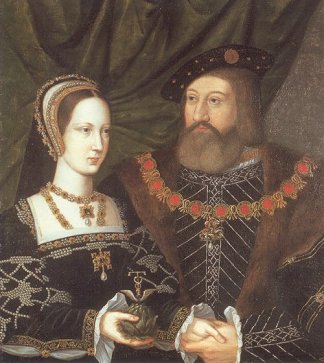 Charles
Brandon, duke of Suffolk, was Henry VIII's closest friend.
Charles
Brandon, duke of Suffolk, was Henry VIII's closest friend.
Brandon's father was Henry VII's standard-bearer at the Battle of Bosworth Field and died defending the future king. Henry VII repaid his loyalty by educating young Charles with his own children, and from the beginning Charles and the future Henry VIII were devoted friends. But their friendship was sorely tested when
Brandon secretly married Henry's favorite sister, the beautiful Princess Mary
Tudor { The ship The Mary Grace was named after her. } . At this page, you can learn more about their romantic story and its aftermath.
| - - - - -
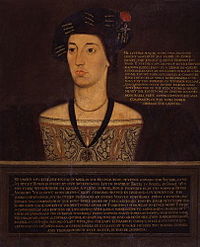 Sir Anthony Browen Knight
[Mr] Master of the
Kings majesty horses, and of his graces privy Chamber - He was
made a Knight
of the Garter in 1540...Sometime after 1540, he married Elizabeth
Fitzgerald, daughter of the 9th Earl
of Kildare, his wife Alice having died....
Sir Anthony Browen Knight
[Mr] Master of the
Kings majesty horses, and of his graces privy Chamber - He was
made a Knight
of the Garter in 1540...Sometime after 1540, he married Elizabeth
Fitzgerald, daughter of the 9th Earl
of Kildare, his wife Alice having died....
| - - - -
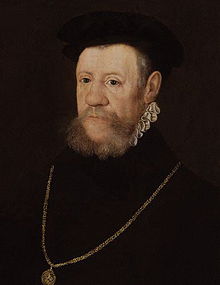 Henry
Lorde Marquis of Dorset is Henry FitzAlan, 19th Earl of Arundel (23 April
1512 – 24 February 1580) was an English nobleman, who over his long life
assumed a prominent place at the court of all the later Tudor sovereigns,
probably the only person to do so.
Henry
Lorde Marquis of Dorset is Henry FitzAlan, 19th Earl of Arundel (23 April
1512 – 24 February 1580) was an English nobleman, who over his long life
assumed a prominent place at the court of all the later Tudor sovereigns,
probably the only person to do so.
...
In 1540 he was appointed deputy of Calais.
He remained there, improving the fortifications at his own expense, until his
father's death in early 1544. He returned to England to assume the earldom, and
was made a Knight
of the Garter. War with France soon brought him back to the continent, where
he spent much of 1544. He then returned to England, where the king appointed him
Lord
Chamberlain.
| - - - - -
William Gonson - Wm. Gonson, paymaster of the King's ships, for " maryne causes," Just a few years earlier his son was executed and a Templar connection....
David Gunston
- Knight of Malta- Ven. David Gonson (Gunston),
Knight of St. John
Martyred at St. Thomas Waterings, Southwark, 12th July, 1541.
1541 - David Gunston - Knight of Malta- Ven. David Gonson (Gunston), Knight of St. John Martyred at St. Thomas Waterings, Southwark, 12th July, 1541. - David Gunston was imprisoned in the Tower of London in 1540 and was condemned to death by an Act of Parliament in 1541 for denying the authority of the King in spiritual matters. He was hanged, drawn and quartered at St. Thomas' Waterings, Southwark on 12 July 1541.
July 7, 1539, Henry VIII had unsuccessfully required the English knights in Malta to disavow the authority of the Pope.
David
Gonson was received into the English Auberge at Malta - on 20th October,
1533, and submitted his "proofs of nobility"; for each applicant for
admission as a Knight of justice must produce proofs of gentle birth, of
legitimacy, of good health, and of good character. David could prove his right
to bear the arms of Gonson quartering Tussell, Walter, Beckett, Young and
Colfax. He was the fourth son of William
Gonson by his marriage with Bennet Walter, sister and heiress of John
Walter.
William Gonson was a Gentleman Usher of the King's Chamber and later
became responsible for the naval administration of this country. In one
contemporary record he is called Vice-Admiral and Paymaster of the Navy. He
did at one time command ships but his principal work was covered by the later
title " Treasurer of Marine Causes," and he is so described in the
Gonson pedigree.
David's eldest brother Benjamin was "Surveyor of all our Shippes" in 1546 and " Treasurer of Marine Causes " in 1549.
Benjamin Gonson - was born Abt. 1506 in Deptford, Kent, England, (he would have been 37 in 1543)
Benjamin's Daughter Katherine married Sir John Hawkins, the famous sea captain. The name Gonson was pronounced as if Goonson, and was sometimes written Gunston. It is as Sir David Gunston that the knight is found in the list of English Martyrs. He was hanged, drawn and quartered at Southwark (London) on 12 July 1541 under the English Act of Supremacy. Blessed David was one of the older sons of Admiral William Gunson, sometime Treasurer of the Navy and Esquire of the Body to King Henry VIII.
The martyr's father, in fact, was William Gonson, captain of the 'Mary Grace' in 1513 and subsequently Paymaster of the Royal Navy. William Gonson's correspondence is plentifully scattered up and down among the state papers of the reign of Henry VIII. A letter to Cromwell mentions his wife in 1536. She died in 1544. Apart from this and his friendship with Cromwell10, Lord Lisle and other important officials, there is nothing personal that can be gathered from these letters.
The death of his son did not affect William Gonson's position. He obtained a grant of arms11 under Henry VIII. His profession is portrayed by the symbolism of a gun between two anchors.
A brass was erected in the church of Melton Mowbray, Leics., to the memory of Christopher Gonson and his wife Elizabeth in 1543 by Bartholomew, Rector of the same church, his son. The inscription states that they had another son William, who was Esquire of the Body to King Henry VIII12. He was, of course, the father of the subject of our enquiry. He named one of the King's ships the 'Christopher Gonson' - doubtless after his own father. Elizabeth Gonson of this brass was the daughter and heir of Roger Trussell of Essex.
William Gonson, Treasurer of the Navy, was the father of Benjamin Gonson, also Treasurer of the Navy and the Grandfather of Dame Katherine Gonson who married Sir John Hawkins, who held the office of Treasurer from 1573, when Benjamin Gonson resigned in favor of his son-in-law, until his death in 1595.
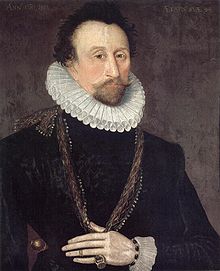 Admiral
Sir John Hawkins (also spelled as John Hawkyns) (Plymouth
1532 – 12 November 1595) was an English shipbuilder, naval administrator and
commander, merchant,
navigator,
and slave
trader. As treasurer (1577) and controller (1589) of the Royal
Navy, he rebuilt older ships and helped design the faster ships that
withstood the Spanish
Armada in 1588. ... The first Englishman recorded to have taken slaves from
Africa was John
Lok, a London trader who, in 1555, brought to England five slaves from Guinea.
A second London trader taking slaves at that time was William Towerson whose
fleet sailed into Plymouth following his 1556 voyage to Africa and from Plymouth
on his 1557 voyage. Despite the exploits of Lok and Towerson, John Hawkins of
Plymouth is widely acknowledged to be the pioneer of the English slave
trade, because he was the first to run the Triangular
trade, making a profit at every stop. ... John Hawkins formed a
syndicate of wealthy merchants to invest in the slave trade.
Admiral
Sir John Hawkins (also spelled as John Hawkyns) (Plymouth
1532 – 12 November 1595) was an English shipbuilder, naval administrator and
commander, merchant,
navigator,
and slave
trader. As treasurer (1577) and controller (1589) of the Royal
Navy, he rebuilt older ships and helped design the faster ships that
withstood the Spanish
Armada in 1588. ... The first Englishman recorded to have taken slaves from
Africa was John
Lok, a London trader who, in 1555, brought to England five slaves from Guinea.
A second London trader taking slaves at that time was William Towerson whose
fleet sailed into Plymouth following his 1556 voyage to Africa and from Plymouth
on his 1557 voyage. Despite the exploits of Lok and Towerson, John Hawkins of
Plymouth is widely acknowledged to be the pioneer of the English slave
trade, because he was the first to run the Triangular
trade, making a profit at every stop. ... John Hawkins formed a
syndicate of wealthy merchants to invest in the slave trade.
In 1595 he accompanied his second cousin Sir Francis
Drake, on a treasure-hunting
voyage to the West
Indies, involving two unsuccessful attacks on San
Juan. During the voyage they both fell sick. Hawkins died at sea off Puerto
Rico. Drake succumbed to disease, most likely dysentery, on January 27, and
was buried at sea somewhere off the coast of Porto Belo.
1535 - Sebastian
Newdigate (Nedygate) dies in the Tower for denying the King's supremacy
- Arrested on 25 May, 1535, for denying the king's supremacy, he was thrown
into the Marshalsea prison, where he was kept for fourteen days bound to a
pillar, standing upright, with iron rings round his neck, hands, and feet.
There he was visited by the king who offered to load him with riches and
honours if he would conform. He was then brought before the Council, and sent
to the Tower, where Henry visited him again. His trial took place, 11 June,
and after condemnation he was sent back to the Tower. With him suffered Blessed
William Exmew and Blessed Humphrey Middlemore.
Sebastian
Newdigate He was a younger son of John Newdigate of Harefield
Place, Middlesex, king's sergeant, and Amphelys, daughter and heiress of
John Nevill of Sutton, Lincolnshire. He was educated at Cambridge, and on going
to Court became and intimate friend of Henry VIII and a privy councillor
Sebastian Newdigate (died c. 1535) was a Roman Catholic priest and
Carthusian monk, of England
 The
Carthusian Order, also called the Order of St. Bruno, is a Roman
Catholic religious order of enclosed monastics. The order was founded by Saint
Bruno of Cologne in 1084 and includes both monks and nuns. The order has its own
Rule, called the Statutes, rather than the Rule of St Benedict, and combines
eremitical and cenobitic life.
The
Carthusian Order, also called the Order of St. Bruno, is a Roman
Catholic religious order of enclosed monastics. The order was founded by Saint
Bruno of Cologne in 1084 and includes both monks and nuns. The order has its own
Rule, called the Statutes, rather than the Rule of St Benedict, and combines
eremitical and cenobitic life.
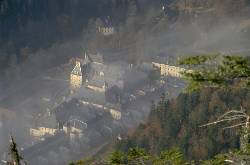 What
is the “Chartreuse” ?
What
is the “Chartreuse” ?
Crusades-Templars
- The Carthusian order is still considered the strictest order of the Roman
Catholic Church - The order famously claims "nunquam reformata quia
nunquam deformata" ("It needs no reform that has never been
deformed.")
- - - - - - - - - - - - So What's a Shallop?
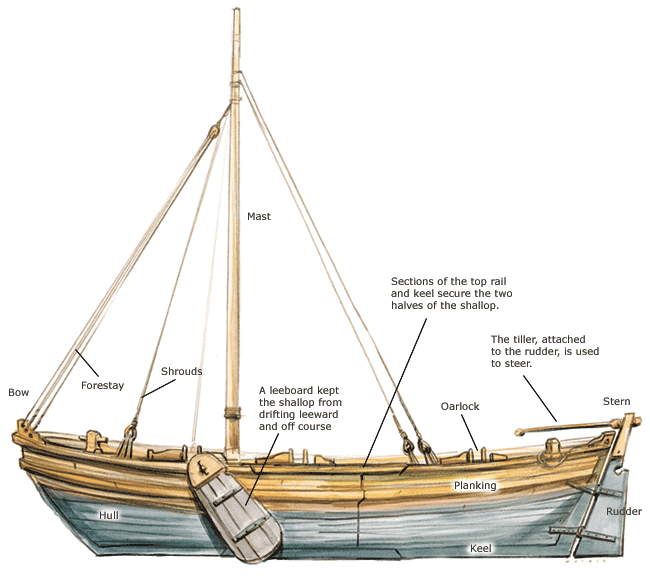 The Shallop –
Captain John Smith Chesapeake National Historic Trail - National Park Service
The Shallop –
Captain John Smith Chesapeake National Historic Trail - National Park Service
In the 1600s, the word “shallop” referred to an open wooden workboat such as a barge, dory, or rowboat. Shallops were small enough to row but also had one or two sails.
Captain John Smith’s shallop could carry 15 men. It was probably about 30 feet long and 8 feet wide. It drew less than 2 feet of water, which was important for navigating the shallow waters of the Chesapeake Bay and many of the tributaries. Like most English boats of the period, the shallop was built of oak planks fastened together with wooden pegs. It had at least one mast and one or two sails made of hemp canvas.
Like a barge, a shallop could carry heavy cargos in shallow water. John Smith described his boat as “open barge neare three tuns burthen”—which meant it could carry up to three tons of cargo. Its exact shape and style remain a mystery. - — it could be powered by oars or sails, travel in deep or shallow waters, and was light enough to pull ashore. In calms, its mast could be lowered and stowed inside the boat.
- - - - - - - - - - - -
Henry VIII Biography
In 1542 Catherine Howard and the three men were executed. In July 1543 Henry
married his sixth wife, Catherine
Parr. She was a good stepmother to Henry's two daughters Mary
and Elizabeth.
Catherine also helped to moderate Henry's religious persecutions. Henry VIII
died in 1547.
1543 - Henry VIII marries Catherine
Parr;
alliance between Henry and Charles V (Holy Roman Emperor) against Scotland and
France
1544 - Henry VIII and Charles V invade
France
Henry's reign marked the birth of English naval power and was a key factor in England's later victory over the Spanish Armada
Henry VIII and Scotland
- In 1543 Henry wrote “A declaration of the cause of war with Scotland”
in which he justified why war against James V was just and why England had a
right to subdue the Scots.
In December 1543 the Scottish Parliament abrogated the treaties it had signed
with England but reaffirmed those Scotland had signed with France. Henry sent
the Earl of Hertford and an army to the Scottish borders. Tthey destroyed
whatever they could so that the region could not support a landing by the French
if one took place in 1544. The show of force was sufficient for some nobles
to swear allegiance to Henry. In September 1545, another attack by the English
on the Borders also destroyed crops and farms.
Humber - Estuary in northeast England formed by the Ouse and Trent rivers, which meet east of Goole and flow east for 60 km/38 mi to enter the North Sea below Spurn Head. It is an important commercial waterway, and the main ports are Kingston upon Hull on the north side, and Grimsby on the south side
Trinity House
- The Corporation came into being in 1514 by Royal
Charter granted by Henry
VIII 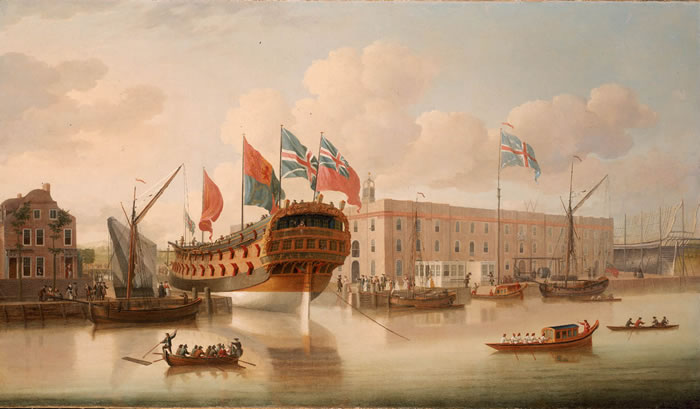 under
the name "The Master, Wardens, and Assistants of the Guild, Fraternity, or
Brotherhood of the most glorious and undivided Trinity, and of St. Clement in
the Parish of Deptford-Strond in the County of Kent." [3].
The first Master was Thomas
Spert, captain of Henry’s flagship Mary
Rose. The name of the guild derives from the church of Holy Trinity and
St Clement, which adjoined the king's new dockyard at Deptford.[4]
under
the name "The Master, Wardens, and Assistants of the Guild, Fraternity, or
Brotherhood of the most glorious and undivided Trinity, and of St. Clement in
the Parish of Deptford-Strond in the County of Kent." [3].
The first Master was Thomas
Spert, captain of Henry’s flagship Mary
Rose. The name of the guild derives from the church of Holy Trinity and
St Clement, which adjoined the king's new dockyard at Deptford.[4]
Trinity Guild was later located in the Tower Ward and the Customs House had been a Trinity house at a Quay property that had been owned by the Outlawe's:
Map of port of London British History Online - No. 9 Gibsons Quay: image
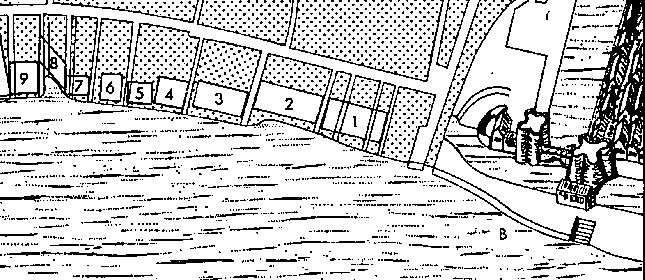
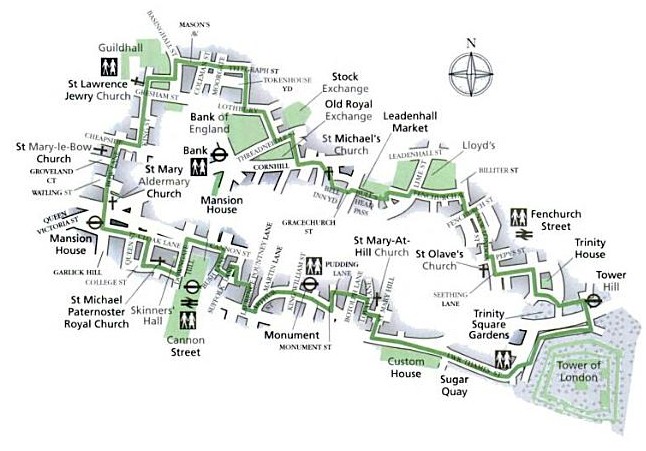
Gibson's quay seems to be gone now and it was between the Sugar Quay building and the customs House - Imported sugar from the plantations brought in with slave ships used to be unloaded at Sugar Quay, then taxed, before being taken for barter at the Royal Exchange
Gibsons
Quay.
Formerly called Asselynes Wharf was West of lane called
Watergate, and south of Thames Street, Watergate is to be identified with Water
Lane, then the site of this Quay or Key is now covered by the Custom House.
There is a St. Dunstans' Wharf: This is 142 Narrow Street Poplar in Limehouse:
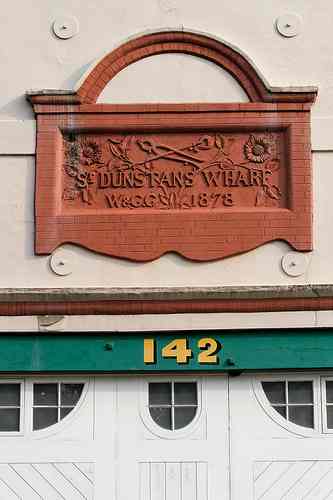
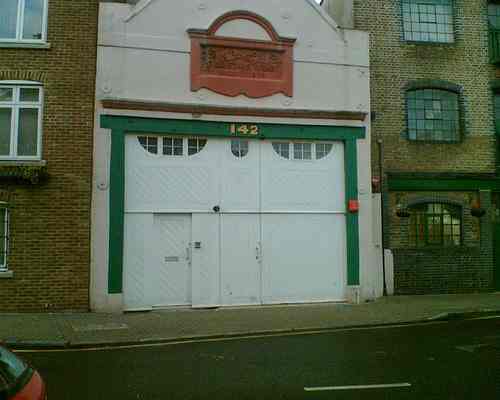
Was Thomas Outlawe Adam Outlawe's Father? Being at the center of London and head of the Pewter's Guild would have been very influential
Thomas Outlawe (Owtlawe) - Pewterers' Company - London - Wardeyn - 1504
1492 - Thomas
Outlawe - 1 acre with a garden on the
southern boundary in Mattishall, the south head of which abutted onto the
King's highway - Mattishall
(Norfolk)
1493 - Inquisition
taken at the Guildhall - London, 23 March, 8 Henry VII [1493], before William
Martyn, Mayor and escheator, after the death of Edward Greene, by the
oath of John Machyn, Thomas Outlawe, John Gage, Thomas Couper, William
Wodestok, Henry Calvar, Thomas Rayner, Thomas Lybbys, Nicholas Jefray, William
Cambre, Richard Spycer, John Broune, John Knyght, Thomas Chamberleyn, and
Richard William - GUILDHALL
London - Guildhall,
London
1493 - Death
of Ellen Wodeward witnessed by Thomas Outlawe
- London - 23 March, 8 Henry VII
1497 - Death
of Richard Chamberleyn witnessed by Thomas
Outlawe - London - 4 March, 12 Henry VII - 1497
History of the Worshipful company of pewterers of the city of London. - Google Books
 The Worshipful
Company of Pewterers is one of the older Livery Companies in the City of London.
It is number 16 in the order of civic precedence among over a hundred companies.
The earliest documented reference to it is in the records of the Corporation
dated 1348 when the "goodfolk, makers of vessels of pewter" came
before the Mayor and Aldermen asking for approval of the Articles which they had
drawn up for the regulation of the trade.
The Worshipful
Company of Pewterers is one of the older Livery Companies in the City of London.
It is number 16 in the order of civic precedence among over a hundred companies.
The earliest documented reference to it is in the records of the Corporation
dated 1348 when the "goodfolk, makers of vessels of pewter" came
before the Mayor and Aldermen asking for approval of the Articles which they had
drawn up for the regulation of the trade.
CHARTERS Edward IV granted the first Charter of the Company on 20th January 1474 (1473 in the calendar of the day). In addition to licensing the Freemen of the Mistery of Pewterers to found a Fraternity, it allowed the Guild to regulate the standard of workmanship, the training of craftsmen and the wages and prices to be set. This Charter granted the Guild the right of search throughout England to ensure the quality of pewter was maintained.
The first Hall, completed in 1496, was destroyed in the Great Fire of London. (1666)